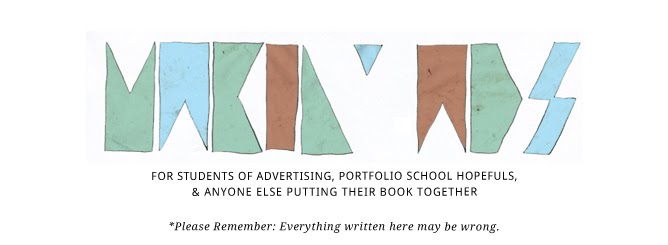
I can't think of any time in my career where I went into a meeting, presented work and had no revisions to make coming out. How you handle feedback and present revisions can be a make-or-break step in the process. Over-react to a off-handed client comment and you can unnecessarily water down or complicate your work. Ignore client concerns and you might come across as unresponsive and torpedo the whole project.
Here are a few things to keep in mind as you run the revision gauntlet:
IN THE FIRST PRESENTATION
1) Listen to feedback. Take notes. Some creatives like to come in, look cool, present the work, then leave. But the most important part of a client relationship is listening. And unless you have a photographic memory, take out a pen and paper. After the meeting, there will be discussions about what exactly the client said and it's good to have your own notes.
Note all of the feedback, even from the junior clients. If there are pertinent quotes from clients, write them down (and note who said them). Nothing lets a client know you listened more than, a week or two later, being able to quote them in a meeting, or being able to say that something they said led you to a solution (this does happen).
2) Make sure you understand which feedback needs to be addressed. Depending on the client, many many people may throw out thoughts. Some of it will be overruled, some of it will be ignored by the group, some of it will be irrelevant, and some of it will be very very important. What you need to be absolutely clear on is which issues you will be addressing with your revisions. A good account person will sum up the feedback at the end of the meeting. If they don't, you should verify what was agreed upon. "So, what I heard was..." or "Just to be clear, for next steps we'll..."
3) Try to avoid executional feedback by understanding the issues. Good clients know that the most helpful feedback for an agency is issue-based rather than executional, but even the most seasoned client will make executional comments from time to time. For example, "I feel like the tone is too frivolous for our brand," is an issue. "I don't like the words "itty-bitty" is executional. "The spot feels rushed" is an issue. "Take out this shot, that shot, and that shot," is executional. You want to get issue-based feedback because there may be several ways to solve an issue, whereas something like "take out that shot" has only one solution and may not be the best for the spot.
4) If you disagree, discuss it. (This has the major caveat of "if you are in a position to do so." If you are a junior creative and your creative director has already agreed to a client request, you are not in a position to voice a dissenting opinion. Nor are you, if you're a junior creative, in a position to argue with a CEO). Be clear that you're in a different place, but avoid being too confrontational. I don't even like saying things like "One could argue that..." That positions it as an argument. Client meetings, though they may sometimes seem like it, are not debates. You're on the same team.
One non-confrontational phrase that can be very helpful is, "Help me understand..." to probe the client issues. Phrasing your point-of-view as a question, or simply explaining why you made the choices you did are also good ways to make a point without seeming combative.
5) Know what's worth fighting for. If your list is "everything," you're going to have a tough time. Some things aren't worth fighting for. Then there are some that are. If you feel strongly that a change completely compromises the integrity of the creative, speak up. And as a last resort, recommend that you take the creative off the table and go try a different approach completely.
6) It's okay to say "Let me think about it." It's an easy trap to fall into to think that you need to solve an issue at the table, or that you need to decide if a suggestion will or won't work right there on the spot. Reserve the right to walk away and take the time to think of an appropriate solution. Clients should respect this.
IN THE REVISIONS MEETING
7) Make sure you addressed your client's concerns. This is a no-brainer. Just double-check before the meeting. It's not pretty when you don't.
8) If you find a better way, STILL make sure you address your client's concerns. This goes for suggestions from your creative director in pre-client meetings as well. If you agree to a revision, DO NOT come to the next meeting without making it. If you get specific executional direction, you'd best follow it. If you come up with an alternative solution, bring that IN ADDITION TO (but definitely not instead of) the agreed-upon revision. Then you can have a discussion about it.
9) Let the client know you heard their concerns. Set up the work by listing what the objectives of the revisions were. What issues did you address? This is the part where your notes from the first meeting come in handy. If one client had a concern, let them know that you made a revision for them. If necessary, explain how you addressed their concerns before you go through the work.
Revisions are a part of the business, so learn how to handle them. They're not necessarily a bad thing, but you have to know how to fend off the ducks or your brilliant idea might get pecked to death. The key is to keep bringing back great work each time. If you do that, you'll only produce great work.
